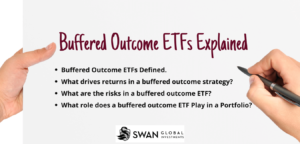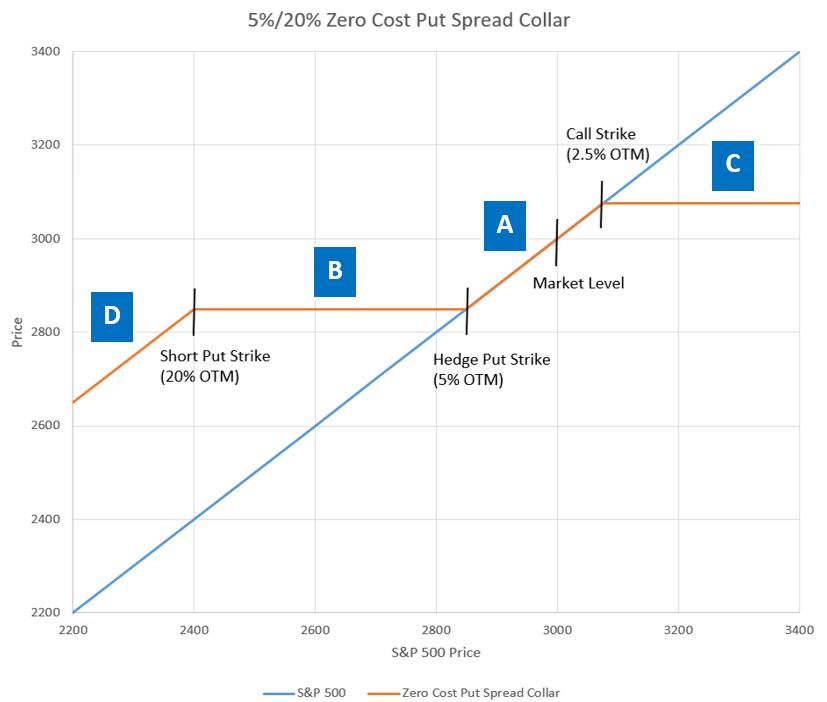This site uses cookies. By continuing to browse the site, you are agreeing to our use of cookies. Privacy Policy
Okay, thanks
One recent innovation that has taken the financial marketplace by storm is buffered outcome ETFs. Also known as defined outcome, target outcome, or structured outcome, these strategies have found an audience with investors who wish to have some upside potential with their investments but are wary of a market sell-off. According to Morningstar, there are well over 100 ETFs with over $8bn in AUM as of August 2021. All of this has occurred within the last three years. In this post we will discuss:
Most buffered outcome ETFs employ some version of a trade known as a put-spread collar. Therefore, referring to Swan’s post on put-spread collars will help in understanding buffered ETFs.
A buffered outcome ETF typically has four components:
The premium collected from the two short positions (i.e. #3 and #4) is used to offset the cost of the hedge (#2). Often these trades are constructed to be “zero cost”, meaning the premium collection from the two short positions is meant to net out the cost of the hedge as closely as possible.
This begets the question: “If most buffered outcome ETFs use this basic put-spread collar trade, how can there be so many different products on the market?”
It is true that buffered outcome ETFs share many core characteristics. Across the range of 100+ products, there are more similarities than differences. That said, the primary difference in the various buffered ETF products has to do with the trade-off between upside and downside. How much upside does a buffered ETF have before it is capped out versus how much downside does the ETF experience before the hedge start to prevent losses? There are dozens of variations of buffered outcome ETFs designed for outcomes ranging from conservative to aggressive.
The language that has been developed to detail the differences regarding buffered outcome ETFs usually focuses on the protection range. It is usually communicated as two numbers such as 5/20 where the first number indicates the amount that the investor will lose in a market decline up to that number. The second number indicates the end of the protection zone where the investor will match further market losses. So, in plain English, if someone described a buffered product as “5/20”, then within the defined outcome period, that investor 1) could expect to lose 5% in their investment if the market was down 5%, 2) would be sheltered from losses in the market beyond 5%, up until 3) the market is down 20%. If the market continues to drop beyond 20% the investor is exposed to those losses.
Let’s take a look at the “5/20” put spread collar to see the structure of this options trade.

Source: Swan Global Investments
There are many variations on this theme. We used 5/20 as an example, but 0/15, 5/35, 0/9 are all possible pay-offs too. There is really no limit to the way these buffered outcome ETFs can be structured, which is why there are so many on the market.
The astute reader might ask, “If the points where the protection begins and ends are defined, then what about the cap? Why isn’t that specified?”
The answer is the upside cap (when the buffered ETF no longer participates with upside market movement) is usually the variable in the equation. These trades are often established with the goal of being “zero cost”, meaning that the cost to purchase the long put is offset by the premium gained by writing the short put and the short call. If the strike prices of two of these three positions are set in stone, that means the third position, the short call, must be a variable. The strike price is a “plug” number to keep the two sides of the equation in balance. In plain English, sometimes the cap will be set higher, sometimes the cap will be lower. It just depends on market conditions. Periods of higher market volatility tend to offer this trade structure higher upside caps, while lower volatility will offer lower upside caps.
The primary driver of returns for buffered outcome ETFs will simply be the returns of the underlying asset, in most cases the S&P 500. What matters, however, is the direction and the scale and of the returns.
Assuming that the buffered ETF is utilizing a simple put-spread collar trade, the following could be expected:
To the downside, once the market falls past the first inflection point the buffered ETF should be sheltered from further losses, up until the point of the second inflection point. After the second inflection point the buffered ETF’s return will be fully exposed to further losses in the market. Please see the post on put-spread collars for further explanation.
The risks to most buffered ETFs lie in the extremes. If the market is up a lot, the buffered ETF will not enjoy gains beyond a certain point. If markets sell off too much, the buffered ETF is exposed to open-ended losses. The former is an opportunity cost and the latter is a very real risk to capital.
In addition, it should be noted that the specific returns advertised by these products are almost never realized given that those returns rely on investment on a specific date and holding the investment through expiration (e.g., one year). Investors who join after the launch or leave the series before the end of the period may receive far different returns. The structured returns are only there for investors who invest on a particular date and then stay the entire time.
Buffered ETFs may be used in a number of ways, including as an equity diversifier or as a means to move cash ‘off the sidelines’ while attempting to mitigate risk. Given these ETFs have a defined outcome period, or expiration date, investors will need to consider what to do after the outcome period ends and the potential market conditions at that time. Again, the risk mitigation zones can be structured, but the corresponding upside cap may be different over time, as mentioned above.
.
As mentioned previously, a vast number of variations of buffered products have been released over the last few years. This is both a good thing and a bad thing. On a positive note, there are variants of the buffered ETFs to fit just about any risk profile, from very conservative to very aggressive. If an investor has a specific buffer in mind, odds are that someone has an ETF to match.
On the downside, this means the investor must really do their due diligence and understand the trade-offs between upside potential and downside risks before investing in a particular strategy. Also, as all the “basic” variations of buffered outcome strategies have been released, many ETF companies are developing the next generation of buffered ETFs that might be more exotic than a basic put-spread collar. These variations might have risks that differ significantly from a basic put-spread collar and might impact an investor portfolio in unexpected ways.
Our portfolio managers and analysts are dedicated to creating relevant, educational Articles, Podcasts, White Papers, Videos, and more.
Marc Odo, CFA®, FRM®, CAIA®, CIPM®, CFP®, Director of Investment Solutions, is responsible for helping clients and prospects gain a detailed understanding of Swan’s Defined Risk Strategy, including how it fits into an overall investment strategy. His responsibilities also include producing most of Swan’s thought leadership content. Formerly Marc was the Director of Research for 11 years at Zephyr Associates.
Our portfolio managers and analysts are dedicated to creating relevant, educational Articles, Podcasts, White Papers, Videos, and more.
Swan Global Investments is an SEC registered Investment Advisor that specializes in managing money using the proprietary Defined Risk Strategy (DRS). Please note that registration of the Advisor does not imply a certain level of skill or training. All investments involve the risk of potential investment losses as well as the potential for investment gains. Prior performance is no guarantee of future results and there can be no assurance that future performance will be comparable to past performance. This communication is informational only and is not a solicitation or investment advice. Further information may be obtained by contacting the company directly at970-382-8901 or www.swanglobalinvestments.com. 279-SGI-102121